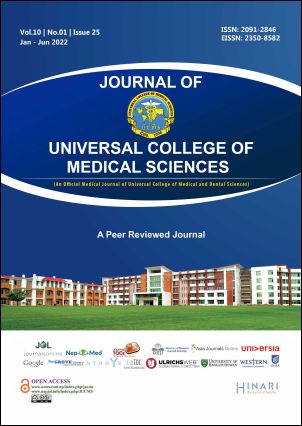Reliability of ‘Ottawa Ankle Rules’ in Acute Ankle and Midfoot Injuries
DOI:
https://doi.org/10.3126/jucms.v10i01.47218Keywords:
Ankle injury, Midfoot injury, Ottawa ankle rulesAbstract
INTRODUCTION
The Ottawa ankle rules (OARs) are clinical decision guidelines used to identify whether patients with ankle injuries need to undergo radiography. The OARs have been proven that their application reduces unnecessary radiography.
MATERIAL & METHODS
This prospective study was conducted at Sumeru City Hospital, Lalitpur in the Department of Emergency and Outpatient Department of Orthopaedics. Thirty-six patients were included in the study. Twenty-five patients were in ankle group and 11 patients were in midfoot group. All patients were sent for X-rays after evaluating them according to OARs.
RESULTS
Among 36 cases, 8 clinically significant fractures were found. Sensitivity of OARs for detecting fractures was 100 % for both ankle and midfoot group. Specificity of OARs for detecting fractures were 47.36 % for ankle group and 66.67 % for midfoot group. Negative predictive value of OARs was 100 %.
CONCLUSION
OARs are very accurate and highly sensitive tools for detecting fractures in acute ankle and midfoot injuries. Implementation of these rules would lead to significant reduction in the number of radiographs and thereby reduce the cost of the treatment, radiation exposure and waiting time of patients at hospital.
Downloads
Downloads
Published
How to Cite
Issue
Section
License
Copyright (c) 2022 Journal of Universal College of Medical Sciences

This work is licensed under a Creative Commons Attribution-NonCommercial 4.0 International License.
Authors have to give the following undertakings along with their article:
- I/we declare that this article is original and has not been submitted to another journal for publication.
- I/we declare that I/we surrender all the rights to the editor of the journal and if published will be the property of the journal and we will not publish it anywhere else, in full or part, without the permission of the Chief Editor.
- Institutional ethical and research committee clearance certificate from the institution where work/research was done, is required to be submitted.
- Articles in the Journal are Open Access articles published under the Creative Commons CC BY-NC License (https://creativecommons.org/licenses/by-nc/4.0/)
- This license permits use, distribution and reproduction in any medium, provided the original work is properly cited, and it is not used for commercial purposes.




